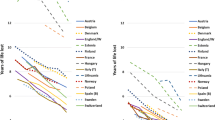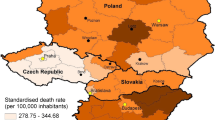Abstract
Objectives
We quantified the impact of reducing socioeconomic inequalities in risk factors on mortality and mortality inequalities in South Korea.
Methods
The mortality risk function from the 12-year mortality follow-up data of the National Health Insurance Service-National Health Screening Cohort, the prevalence of major risk factors from the Korea National Health and Nutrition Examination Survey 2013–2015, and the Health Plan 2020 (HP2020) goals for major risk factors were used to estimate the magnitude of reduction in mortality inequalities by changing the magnitude of income-based inequalities in risk factors in various scenarios under gender-specific models among participants aged 40–79 years.
Results
The greatest reduction in absolute and relative inequalities in mortality would occur if the low-income group achieved the HP2020 goals earlier than the high-income group. A 10–20% reduction in all-cause mortality inequalities was expected if absolute gaps between income groups in risk factors were halved.
Conclusions
With the practical goal halving the socioeconomic gaps in modifiable risk factors, reducing inequalities in all-cause mortality by 10–20% would be possible. Further reduction in mortality inequalities would need more aggressive policies on social determinants of health.


Similar content being viewed by others
References
Alvarado BE, Harper S, Platt RW et al (2009) Would achieving healthy people 2010’s targets reduce both population levels and social disparities in heart disease? Circ Cardiovasc Qual Outcomes 2:598–606
Bahk J, Lynch JW, Khang YH (2017) Forty years of economic growth and plummeting mortality: the mortality experience of the poorly educated in South Korea. J Epidemiol Community Health 71:282–288
Commission on Social Determinants of Health (CSDH) (2008) Closing the gap in a generation: health equity through action on the social determinants of health. Final report of the commission on social determinants of health. World Health Organization, Geneva
Crombie IK, Irvine L, Elliott L et al (2005) Closing the health inequalities gap: an international perspective. WHO Regional Office for Europe, Copenhagen
D’Agostino RBS, Grundy S, Sullivan LM et al (2001) Validation of the Framingham coronary heart disease prediction scores: results of a multiple ethnic groups investigation. JAMA 286:180–187
Department of Health (2009) Mortality target monitoring (life expectancy and all-age all-cause mortality, overall and inequalities). http://www.thehealthwell.info/node/9646
Di Cesare M, Khang YH, Asaria P et al (2013) Inequalities in non-communicable diseases and effective responses. Lancet 381:585–597
Eikemo TA, Hoffmann R, Kulik MC et al (2014) EURO-GBD-SE consortium. How can inequalities in mortality be reduced? A quantitative analysis of 6 risk factors in 21 European populations. PLoS ONE 9:e110952
Haber R, Wong E (2013) Learning from others. Comprehensive health equity strategies in Europe. Wellesley Institute, Toronto
Harper S, Lynch J (2006) Measuring health inequalities. In: Oakes JM, Kaufman JS (eds) Methods in social epidemiology. Wiley, New York, pp 134–168
Health 21 (1999) The health for all policy framework for the WHO European region. World Health Organization Regional Office for Europe, Copenhagen
Hoffmann R, Eikemo TA, Kulhánová I et al (2013) The potential impact of a social redistribution of specific risk factors on socioeconomic inequalities in mortality: illustration of a method based on population attributable fractions. J Epidemiol Community Health 67:56–62
Hoffmann R, Eikemo TA, Kulhánová I et al (2015) Obesity and the potential reduction of social inequalities in mortality: evidence from 21 European populations. Eur J Public Health 25:849–856
Hosmer DW, Lemeshow S (2000) Applied logistic regression, 2nd edn. Wiley, New York
Jung-Choi K, Khang YH (2011) Contribution of different causes of death to socioeconomic mortality inequality in Korean children aged 1–9: findings from a national mortality follow-up study. J Epidemiol Community Health 65:124–129
Jung-Choi K, Khang YH, Cho HJ (2011) Socioeconomic differentials in cause-specific mortality among 1.4 million South Korean public servants and their dependents. J Epidemiol Community Health 65:632–638
Khang YH, Kim HR (2005) Explaining socioeconomic inequality in mortality among South Koreans: an examination of multiple pathways in a nationally representative longitudinal study. Int J Epidemiol 34:630–637
Khang YH, Lee SI (2012) Health inequalities policy in Korea: current status and future challenges. J Korean Med Sci 27(Suppl):S33–S40
Khang YH, Lynch JW, Jung-Choi K et al (2008) Explaining age-specific inequalities in mortality from all causes, cardiovascular disease and ischaemic heart disease among South Korean male public servants: relative and absolute perspectives. Heart 94:75–82
Khang YH, Lynch JW, Yang S et al (2009) The contribution of material, psychosocial, and behavioral factors in explaining educational and occupational mortality inequalities in a nationally representative sample of South Koreans: relative and absolute perspectives. Soc Sci Med 68:858–866
Kim YJ, Lee JS, Park J et al (2017) Trends in socioeconomic inequalities in five major risk factors for cardiovascular disease in the Korean population: a cross-sectional study using data from the Korea National Health and Nutrition Examination Survey, 2001–2014. BMJ Open 0:e014070
Kivimaki M, Shipley MJ, Ferrie JE et al (2008) Best-practice interventions to reduce socioeconomic inequalities of coronary heart disease mortality in UK: a prospective occupational cohort study. Lancet 372:1648–1654
Kulhánová I, Menvielle G, Hoffmann R et al (2016) EURO-GBD-SE consortium. The role of three lifestyle risk factors in reducing educational differences in ischaemic heart disease mortality in Europe. Eur J Public Health 26:1081–1088
Kulik MC, Hoffmann R, Judge K et al (2013) Smoking and the potential for reduction of inequalities in mortality in Europe. Eur J Epidemiol 28:959–971
Kweon S, Kim Y, Jang MJ et al (2014) Data resource profile: the Korea National Health and Nutrition Examination Survey (KNHANES). Int J Epidemiol 43:69–77
Lynch JW, Davey Smith G, Harper S et al (2006) Explaining the social gradient in coronary heart disease: comparing relative and absolute approaches. J Epidemiol Community Health 60:436–441
Mackenbach JP, Kunst AE (1997) Measuring the magnitude of socio-economic inequalities in health: an overview of available measures illustrated with two examples from Europe. Soc Sci Med 44:757–771
Mackenbach JP, Stirbu I, Roskam AJ et al (2008) Socioeconomic inequalities in health in 22 European countries. N Engl J Med 358:2468–2481
Mäki NE, Martikainen PT, Eikemo T et al (2014) EURO-GBD-SE consortium members. The potential for reducing differences in life expectancy between educational groups in five European countries: the effects of obesity, physical inactivity and smoking. J Epidemiol Community Health 68:635–640
McAuley A, Denny C, Taulbut M et al (2016) Informing investment to reduce inequalities: a modelling approach. PLoS ONE 11:e0159256
Ministry of Health and Welfare (2011) The national health plan 2020. Seoul: Ministry of Health and Welfare, pp 95–96 (in Korean)
Ministry of Health and Welfare and Korea Institute for Health and Social Affairs (2005) Establish of new health plan 2010. Seoul: Ministry of Health and Welfare and Korea Institute for Health and Social Affairs, pp 42–46, p 883
Östergren O, Martikainen P, Lundberg O (2018) The contribution of alcohol consumption and smoking to educational inequalities in life expectancy among Swedish men and women during 1991–2008. Int J Public Health 63(1):41–48
Phelan JC, Link BG, Tehranifar P (2010) Social conditions as fundamental causes of health inequalities: theory, evidence, and policy implications. J Health Soc Behav 51(Suppl):S28–S40
Scholes S, Bajekal M, Norman P et al (2013) Quantifying policy options for reducing future coronary heart disease mortality in England: a modelling study. PLoS ONE 8:e69935
Seong SC, Kim Y-Y, Park SK et al (2017) Cohort profile: the National Health Insurance Service-National Health Screening Cohort (NHIS-HEALS) in Korea. BMJ Open 7:e016640
Seoul Metropolitan Government (2013) Healthy Seoul 36.5 project. https://opengov.seoul.go.kr/public/86721
Smith BT, Smith PM, Harper S et al (2014) Reducing social inequalities in health: the role of simulation modelling in chronic disease epidemiology to evaluate the impact of population health interventions. J Epidemiol Community Health 68:384–389
Son M, Cho Y, Oh J et al (2012) Social inequalities in life expectancy and mortality during the transition period of economic crisis (1993–2010) in Korea. Int J Equity Health 11:71
Speybroeck N, Van Malderen C, Harper S et al (2013) Simulation models for socioeconomic inequalities in health: a systematic review. Int J Environ Res Public Health 10:5750–5780
Stringhini S, Sabia S, Shipley M et al (2010) Association of socioeconomic position with health behaviors and mortality. JAMA 303:1159–1166
Acknowledgements
The authors thank Hee-Yeon Kang for her assistance in preparing the paper. This study was administratively supported by the National Health Insurance Service of Korea (NHIS-2017-2-368). HK Lim and YH Khang were supported by the Mid-career Researcher Program of the National Research Foundation (NRF), funded by the Ministry of Science and ICT (Nos. NRF-2014R1A2A1A11051392 and NRF-2017R1A2A2A05069746). This study was also supported by a grant of the Korea Health Technology R&D Project through the Korea Health Industry Development Institute (KHIDI), funded by the Ministry of Health & Welfare, Republic of Korea (Grant No. HI18C0446).
Author information
Authors and Affiliations
Contributions
Both authors were involved in the planning of the study, implementation of the study, and writing and approving the manuscript. HKL performed the data analysis under the consultation of YHK. Both authors interpreted the results. HKL drafted the manuscript. YHK reviewed and edited the manuscript.
Corresponding author
Ethics declarations
Conflict of interest
The authors declare that they have no conflict of interest.
Ethics approval
The present study protocol was reviewed and approved by the Seoul National University Hospital Institutional Review Board (IRB No. E-1411-001-620).
Additional information
Publisher’s Note
Springer Nature remains neutral with regard to jurisdictional claims in published maps and institutional affiliations.
Electronic supplementary material
Below is the link to the electronic supplementary material.
Rights and permissions
About this article
Cite this article
Lim, HK., Khang, YH. Quantifying the impact of reducing socioeconomic inequalities in modifiable risk factors on mortality and mortality inequalities in South Korea. Int J Public Health 64, 585–594 (2019). https://doi.org/10.1007/s00038-019-01231-2
Received:
Revised:
Accepted:
Published:
Issue Date:
DOI: https://doi.org/10.1007/s00038-019-01231-2




